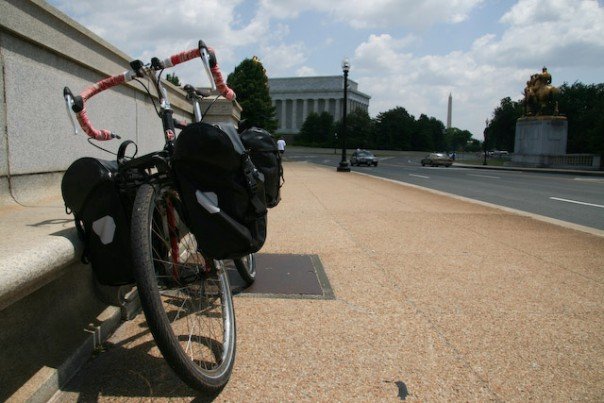Riding Safety

Remember that risks can only be managed and reduced, never eliminated. Use the following recommendations to stay safe and avoid issues on your tour.
- Clothing & Equipment
- Wear a helmet.
- Wear bright, high contract, and reflective clothing
- Use a mirror to see traffic (afterwards, you’ll never want to ride without one)
- Wear sunglasses to protect your eyes from airborne objects, which could compromise your ability to control your bike.
- Use reflectors and lights when riding in the dark or when visibility is limited
- Check your bike for any issues before each ride
- Brakes are fully attached and not too loose
- Quick release levers secured
- No cracks or abnormalities in the frame
- Bolts are firmly secured at stem, headset, racks, etc.
- Coexisting with motor vehicles and other cyclists
- Be alert and attentive at all times. If you can’t pay attention to what’s going on around you, take a break and refocus.
- Chose routes and and roads that have little traffic as much as possible. Research entries and exits in large cities before you get there.
- Ride with traffic, not against it
- Ride as close to the side of the road as safely possible
- Avoid riding two across / double file
- Use hand signals when turning or slowing
- Signal any object on the road to fellow cyclists (cars, pot holes, downed sticks or logs, glass…)
- Environmental Considerations
- Pack rain gear (jacket and pants), especially for tours in cool weather where hypothermia is a risk
- Use sun protection – sunglasses, sunscreen, SPF clothing
- When cold, consider leg warmers, arm warmers, shoe covers, full finger gloves
- When raining, remember that
- it will take longer for your brakes to stop your bike
- visibility is limited for both you and drivers trying to see you
- hypothermia is a risk in cold weather
- it’s important that your gear is stored in waterproof panniers, stuff sacks or zippered plastic bags
- you should always have something dry to change in to at the end of the day
- When hot, be sure to
- Drink enough water
- Replenish your electrolytes with salty and sweet foods or sports drinks
- Avoid riding in the hottest part of the day
- Only rest in the shade
- When windy, be cautious especially if crossing bridges or when close to traffic
- Dogs – opinions vary, but here is a collection of tips to consider:
- Get off your bike and walk and hope the dog loses interest
- If you stop and the dog is still aggressive, communicate that you are in control and not submissive – stand tall, wave your arms, speak in a firm, loud and commanding voice, toss stones in the direction of the dog
- Keep your bike between you and the dog
- If you get bitten, clean the wound by rinsing with soap and water, and seek medical attention (if possible), especially if you suspect the dog has rabies
Preventing Bicycle Theft
“What’s the best lock for bicycle touring?” is a common question. While locks vary in terms of robustness and quality, the greatest factor in not losing your bike is common sense and careful discipline in where you lock it. An experienced determined thief will find a way through any lock if they really want your bike.
Here are a list of common tips:
- Use common sense. If you have a feeling that your bike is not safe, find another solution.
- Tour with others. One of you can always watch the bikes while other shops for lunch in the supermarket.
- Never leave your bike locked up outside a building overnight, especially in cities and large urban areas. If staying in a hotel, hostel or guesthouse, bring it into your room or a secure location inside the building (and then lock it there). Often it’s easier just to bring it in your room without asking.
- Always lock your bike when you can. Many bicycle tourists use a medium thickness cable lock that will secure the frame and both wheels to an external object.
- If camping in remote areas, lock your bike to a tent pole overnight, or use it as a structural component of your tent or tarp. If someone comes after your bike, they’ll likely wake you up.
- If you are touring solo and need to enter a store or restaurant, lock your bike near a window so you can keep tabs on it while shopping or eating. Ask a shop owner or trustworthy-looking person nearby to keep an eye on it for you if possible.
- Don’t advertise flashy, expensive-looking bicycles, components and gear. Many long-distance cycle tourists will spray paint an expensive frame to make it look unattractive.
- When you are not with your bike, keep all critical valuables on your person (wallet, passport, camera, etc.). Handebar bags and daypacks can be easily detached for when you go in a store.
On the Camino, many albergues and guesthouses are bike-friendly, and have enclosed spaces for bicycle storage overnight. It’s a good idea to still lock your bike there (even if to itself or your friend’s bike), and keep any valuables with you where you are sleeping. See our list of bike-friendly albergues. Don’t stay in an albergue that doesn’t have an indoor location to lock your bike.
Shop for food and go out to eat after your bike is secured at your accommodation. Most cafés have outdoor seating where you can eat lunch or sip a morning coffee next to your bike.
If your bike is stolen… 🙁
- Before you leave, purchase travel insurance that will cover theft of your bike and equipment, considering deductibles and claim maximums. See what your homeowner’s insurance covers when traveling.
- Call the police and have a formal report written up. You will need this for any insurance claims. Hopefully you had your wallet and passport on your person.
- Write up your story and share online to help others avoid this situation. Sometimes bike manufacturers will aid you if your sob story is compelling enough
- Consider yourself luckier than this guy touring in Mongolia.




